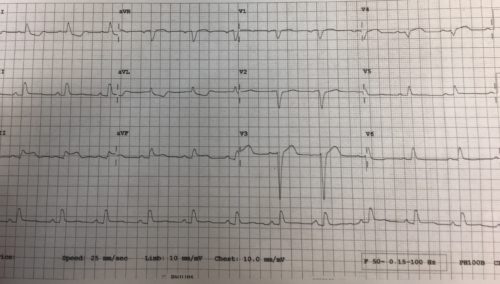A 81 year old male presents to a regional emergency department, 4 hours away from a cath lab, complaining of chest pain. Below is the patients ECG:
Describe and Interpret the ECG
List the contraindications for thrombolysis
Answer:
Rate: 66 beats/min
Rhythm: normal sinus rhythm
Axis: normal axis
Intervals
- PR 160ms
- QRS 130ms
- QTc 430ms
Additional:
Left Bundle Branch Block morphology
Concordant ST elevation of 1-2mm in III and aVF, ST depression V2 and ST elevation V4
The above ECG shows a LBBB, with evidence of STEMI equivalent criteria ie Sgarbossa criteria
- Concordant ST elevation >1mm in > 1 lead
- Concordant ST depression 1mm in V2
- Discordant ST elevation >25% V4
Modified Sgarbossa Cirteria:
- Concordant STE ≥ 1 mm in any lead
- Concordant STD ≥ 1 mm in V1, V2, or V3
- Proportionally excessive discordant STE in ≥ 1 lead anywhere with ≥ 1 mm STE, as defined by ≥ 25% of the depth of the preceding S-wave
As this patient is in a regional area, with no cath lab facilities, thrombolysis needs to be considered. The following are contraindications to thrombolysis:
Absolute contraindications
- aortic dissection
- new neurological signs
- significant head of facial trauma in previous 3 months
- any previous intracranial haemorrhage
- ischaemic stroke within 3 months
- known intracranial vascular malformation
- known malignant intracranial neoplasm (primary or metastatic)
- acute pericarditis
- active bleeding (except menstruation)
Relative Contraindications
- Anticoagulation – risk of bleeding relates to INR
- Non compressible vascular punctures eg transvenous pacing, CVC line insertion
- Hypertension – delay thrombolysis until systolic BP < 180 mmHg or diastolic BP < 110 mmHg
- CPR
- Surgery -major surgery in previous 3 weeks or CNS surgery in previous 2 months
- Gastrointestinal or urinary haemorrhage in previous 4 weeks or active peptic ulcer
- Malignancy
- Menstruation – usually safe as menstrual bleeding is due to endometrial vasoconstriction
- Pregnancy – TPA – classified as category B1
Odds ratio of patient having a ICH post thrombolysis increases if the patient is:
- >75 years
- <70 KG
- Uncontrolled hypertension
- Prior stroke of any type

